TheNZThrower
Active Member
I know I’m three years late and beating a dead horse, but there has been a video released by a fairly well known conservative youtuber called Actual Justice Warrior on the bushfires that ravaged my home nation, Australia. He pins the bulk of the blame on arson and policies prohibiting hazard reduction burns rather than climate change. But is that a fact, or a fallacy?
As AJW mostly parrots his information from this reposted Breitbart article, we shall mostly focus on addressing the claims within. I aim to use only sources that are dated before the publication of AJW’s video, so as to not cite sources against him that he couldn’t have known about. As I am not a climatologist, nor do I have any proper academic training in any climate change related fields, take anything I say with a grain of salt; and make sure to check my sources and point out any errors I may have made in my research.
AJW claims that the past few years leading up to the 2019-2020 bushfire season didn’t have an unusually low rainfall anomaly and hence weren’t unusually dry. He subsequently claims that the past 60 years in Australia were wetter than the 60 years after the start of the instrumental rainfall record, while claiming that the trend is showing that Australia is experiencing greater rainfall and moisture while referencing the following Bureau of Meteorology chart mentioned in the Breitbart article:
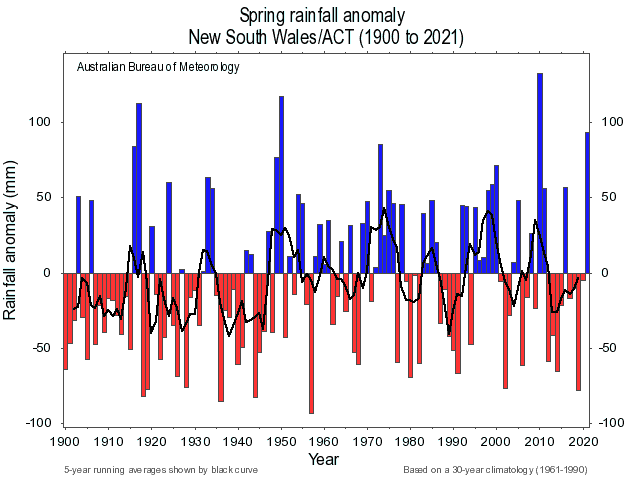
Where do I even begin? How about with the fact that the graph only focuses on spring rainfall anomalies specific only to NSW, rather than annual rainfall anomalies of NSW, let alone the entirety of Australia or even the regions affected by the fires. We have a term for this selective quoting of the data: Cherry picking. The reason why citing rainfall data solely from spring is problematic is because the fire season in NSW extends beyond the middle of spring up to the middle of summer, or from 1 October to 31st March, so spring rainfall alone does not cover the entirety of rainfall experienced during the fire season. That aside, the primary thesis of the Breitbart article, and of AJW by extension, for their assumption that NSW is experiencing more moisture and rainfall is that there are more blue lines in the graph in the (EDIT: second half of the time period documented), which means more years where rainfall is above average. The main reason why the aforementioned line of reasoning is faulty is that it ignores the actual trends in the data as indicated by the trend line I have added back in. If you look at the trend line in black, the spring rainfall anomaly has actually been slightly decreasing; with the only reason why more years recently have had above average rainfall anomaly being a result of a sudden increase in the anomaly around the 1940s, before continuing on the same slight decrease.
Furthermore, contrary to what AJW’s and Breitbart imply, NSW did experience record low rainfall on the year the bushfires hit in 2019 if you not only go by total annual rainfall:
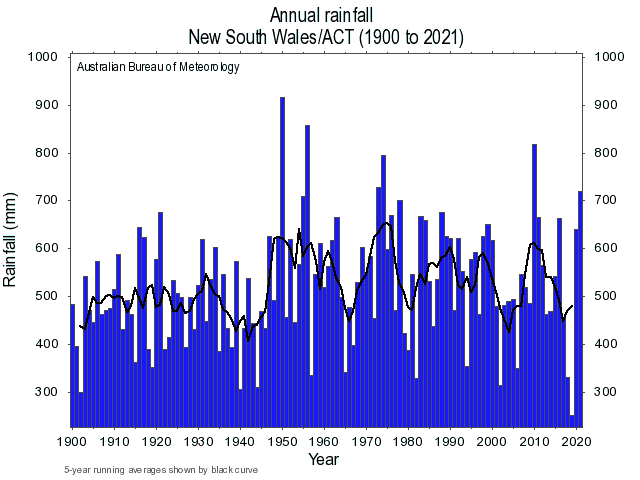
But also by how much rainfall deviates from the long term average (i.e. the rainfall anomaly):
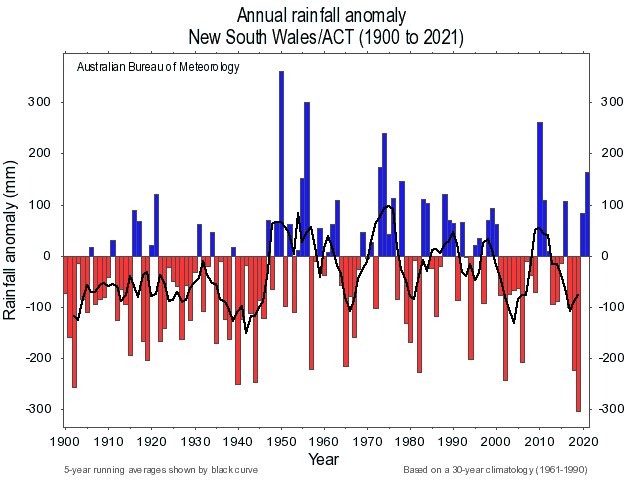
Now if there is something else anyone has noticed, it is that the same decreasing trend in spring rainfall anomaly persists in both the annual rainfall anomaly and total rainfall graphs.
Now if we look further into the Bureau of Meteorology’s report on spring rainfall in NSW in the year of the fires, it states that not only has the rainfall experienced in spring been below average, but it is also the sixth driest spring on record, with more than half of the state recording rainfall in the lowest 10%. In addition, all but one month in NSW have been at their third driest on record. So AJW is fractally wrong when he says that spring 2019 was not an unusually dry season in NSW, as I’m pretty sure that any spring that is in the top 10 driest on record is particularly dry.
That aside, AJW also doesn’t understand that the line of logic that heavier rainfall leads to more moisture and a reduced likelihood of fire is oversimplistic, as there are more variables that affect the moisture in a region than rainfall alone, as temperature also factors into it. As far as I know based on my very limited knowledge on climate science, increased rainfall will only increase moisture if the temperature remains more or less constant. If not, then a sufficient increase in temperature would increase the rate of evaporation of vegetation and soil, which would counteract the effects of the increased rainfall. But even assuming what AJW says about rainfall is true, then greater vegetation growth likely will occur, which means that if it all dries out, it provides more fuel for bushfires to increase in intensity. The record high temperatures NSW is experiencing also reduces the relative humidity of the regional atmosphere by increasing the amount of water vapour that the atmosphere in the region can hold. This increases the rate of evaporation, or transpiration of the plants, which causes them to dry out faster than at lower temperatures. Hence according to my simplistic, rough and probably inaccurate hypothesis owing to my lack of expertise, (EDIT: years of above average rainfall) increases vegetation that could become fuel, and higher temperatures combined with (EDIT: years of below average rainfall that subsequently follow) would lead to drier plants, increasing the amount of fuel available for bushfires.
In addition, the impact of the bushfires extends beyond NSW into VIC & even QLD, though NSW is the hardest hit of them all. Hence this is why rainfall data from Southeastern Australia as a whole is more accurate than from NSW alone. This leads us to observe an even more pronounced version of the prior trends in not only rainfall anomaly:
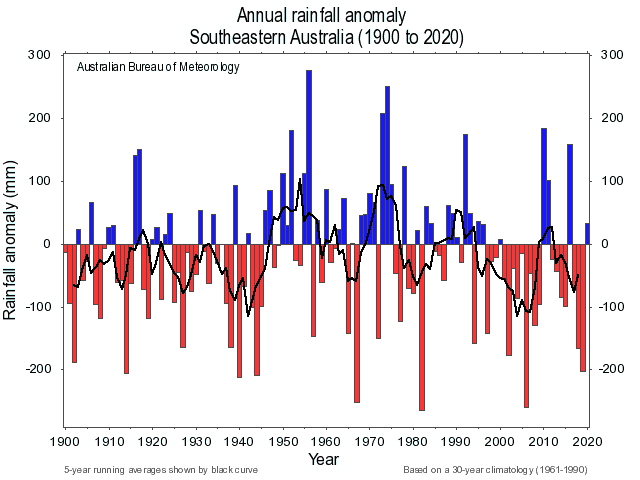
But also total rainfall:
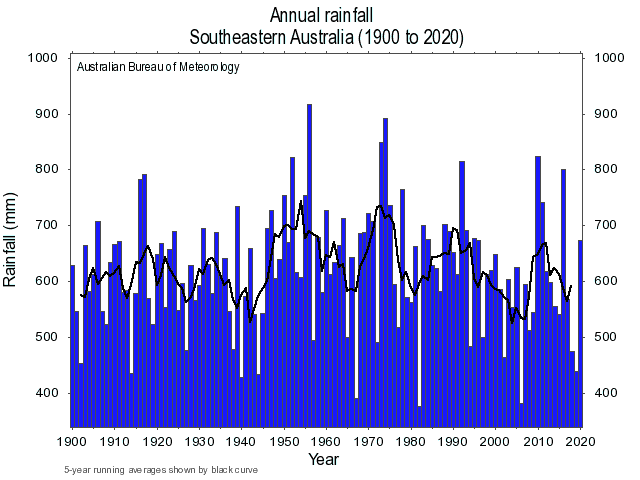
To be continued...
As AJW mostly parrots his information from this reposted Breitbart article, we shall mostly focus on addressing the claims within. I aim to use only sources that are dated before the publication of AJW’s video, so as to not cite sources against him that he couldn’t have known about. As I am not a climatologist, nor do I have any proper academic training in any climate change related fields, take anything I say with a grain of salt; and make sure to check my sources and point out any errors I may have made in my research.
AJW claims that the past few years leading up to the 2019-2020 bushfire season didn’t have an unusually low rainfall anomaly and hence weren’t unusually dry. He subsequently claims that the past 60 years in Australia were wetter than the 60 years after the start of the instrumental rainfall record, while claiming that the trend is showing that Australia is experiencing greater rainfall and moisture while referencing the following Bureau of Meteorology chart mentioned in the Breitbart article:
Where do I even begin? How about with the fact that the graph only focuses on spring rainfall anomalies specific only to NSW, rather than annual rainfall anomalies of NSW, let alone the entirety of Australia or even the regions affected by the fires. We have a term for this selective quoting of the data: Cherry picking. The reason why citing rainfall data solely from spring is problematic is because the fire season in NSW extends beyond the middle of spring up to the middle of summer, or from 1 October to 31st March, so spring rainfall alone does not cover the entirety of rainfall experienced during the fire season. That aside, the primary thesis of the Breitbart article, and of AJW by extension, for their assumption that NSW is experiencing more moisture and rainfall is that there are more blue lines in the graph in the (EDIT: second half of the time period documented), which means more years where rainfall is above average. The main reason why the aforementioned line of reasoning is faulty is that it ignores the actual trends in the data as indicated by the trend line I have added back in. If you look at the trend line in black, the spring rainfall anomaly has actually been slightly decreasing; with the only reason why more years recently have had above average rainfall anomaly being a result of a sudden increase in the anomaly around the 1940s, before continuing on the same slight decrease.
Furthermore, contrary to what AJW’s and Breitbart imply, NSW did experience record low rainfall on the year the bushfires hit in 2019 if you not only go by total annual rainfall:
But also by how much rainfall deviates from the long term average (i.e. the rainfall anomaly):
Now if there is something else anyone has noticed, it is that the same decreasing trend in spring rainfall anomaly persists in both the annual rainfall anomaly and total rainfall graphs.
Now if we look further into the Bureau of Meteorology’s report on spring rainfall in NSW in the year of the fires, it states that not only has the rainfall experienced in spring been below average, but it is also the sixth driest spring on record, with more than half of the state recording rainfall in the lowest 10%. In addition, all but one month in NSW have been at their third driest on record. So AJW is fractally wrong when he says that spring 2019 was not an unusually dry season in NSW, as I’m pretty sure that any spring that is in the top 10 driest on record is particularly dry.
That aside, AJW also doesn’t understand that the line of logic that heavier rainfall leads to more moisture and a reduced likelihood of fire is oversimplistic, as there are more variables that affect the moisture in a region than rainfall alone, as temperature also factors into it. As far as I know based on my very limited knowledge on climate science, increased rainfall will only increase moisture if the temperature remains more or less constant. If not, then a sufficient increase in temperature would increase the rate of evaporation of vegetation and soil, which would counteract the effects of the increased rainfall. But even assuming what AJW says about rainfall is true, then greater vegetation growth likely will occur, which means that if it all dries out, it provides more fuel for bushfires to increase in intensity. The record high temperatures NSW is experiencing also reduces the relative humidity of the regional atmosphere by increasing the amount of water vapour that the atmosphere in the region can hold. This increases the rate of evaporation, or transpiration of the plants, which causes them to dry out faster than at lower temperatures. Hence according to my simplistic, rough and probably inaccurate hypothesis owing to my lack of expertise, (EDIT: years of above average rainfall) increases vegetation that could become fuel, and higher temperatures combined with (EDIT: years of below average rainfall that subsequently follow) would lead to drier plants, increasing the amount of fuel available for bushfires.
In addition, the impact of the bushfires extends beyond NSW into VIC & even QLD, though NSW is the hardest hit of them all. Hence this is why rainfall data from Southeastern Australia as a whole is more accurate than from NSW alone. This leads us to observe an even more pronounced version of the prior trends in not only rainfall anomaly:
But also total rainfall:
To be continued...
Last edited:
